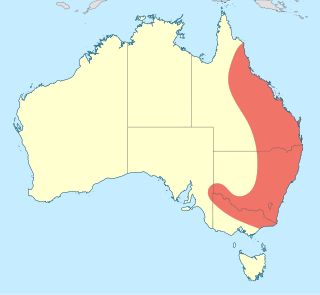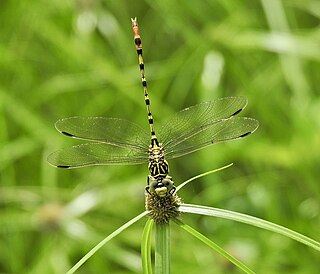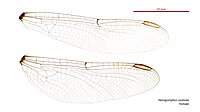
Hemigomphus atratus is a species of dragonfly of the family Gomphidae, known as the black vicetail. It is endemic to north-eastern Queensland, Australia, where it inhabits rainforest streams.

Austroaeschna cooloola is a species of large dragonfly in the family Aeshnidae, known as the Wallum darner. It has been found in south-eastern Queensland, Australia, where it inhabits sandy and densely vegetated streams.

Austrogomphus prasinus, also known as Austrogomphus (Pleiogomphus) prasinus, is a species of dragonfly of the family Gomphidae, commonly known as the lemon-tipped hunter. It inhabits streams and rivers in northern Queensland, Australia.

Austrogomphus divaricatus, also known as Austrogomphus (Pleiogomphus) divaricatus, is a species of dragonfly of the family Gomphidae, commonly known as the fork hunter. It inhabits streams and rivers in northern Queensland, Australia.

Austrogomphus arbustorum, also known as Austrogomphus (Austrogomphus) arbustorum, is a species of very small dragonfly of the family Gomphidae, commonly known as the toothed hunter. It inhabits rivers and pools in northern Queensland, Australia.

Austrogomphus cornutus, also known as Austrogomphus (Austrogomphus) cornutus, is a species of dragonfly of the family Gomphidae, commonly known as the unicorn hunter. It inhabits streams and rivers in eastern Australia.

Zephyrogomphus longipositor is a species of dragonfly in the family Gomphidae, known as the rainforest hunter. It inhabits rainforest streams and pools in northeast Queensland, Australia.

Austroepigomphus gordoni, also known as Austroepigomphus (Xerogomphus) gordoni, and up until recently Austrogomphus gordoni, is a species of dragonfly of the family Gomphidae, commonly known as the western red hunter. It inhabits streams and pools in Western Australia.

Antipodogomphus acolythus is a species of dragonfly of the family Gomphidae, commonly known as the southern dragon. It inhabits streams, rivers and pools in eastern Australia.

Antipodogomphus dentosus is a species of dragonfly of the family Gomphidae, commonly known as the Top End dragon. It is endemic to Northern Territory, Australia, where it has been found in rivers.

Antipodogomphus edentulus is a species of dragonfly of the family Gomphidae, commonly known as the Cape York dragon. It is endemic to Cape York, Queensland, Australia, where it has been found in rivers.

Antipodogomphus neophytus is a species of dragonfly of the family Gomphidae, known as the northern dragon. It is endemic to northern Australia, where it inhabits rivers and pools.

Hemigomphus is a genus of dragonflies in the family Gomphidae, endemic to Australia. The species are small with black and yellow markings. They are commonly known as vicetails.

Hemigomphus comitatus is a species of dragonfly of the family Gomphidae, known as the zebra vicetail. It is endemic to northern Queensland, Australia, where it inhabits streams and rivers.

Hemigomphus magela is a species of dragonfly of the family Gomphidae, known as the Kakadu vicetail. It is a small, black and yellow dragonfly, endemic to Northern Territory, Australia, where it inhabits streams.

Hemigomphus theischingeri is a species of dragonfly of the family Gomphidae, known as the rainforest vicetail. It is a small, black and yellow dragonfly, endemic to northern Queensland, Australia, where it inhabits rainforest streams.

Hemigomphus gouldii is a species of dragonfly of the family Gomphidae, known as the southern vicetail. It is a small, black and yellow dragonfly, endemic to eastern Australia, where it inhabits permanent streams and rivers.

Hemigomphus heteroclytus is a species of dragonfly of the family Gomphidae, known as the stout vicetail. It is a small, black and yellow dragonfly, endemic to eastern Australia, where it inhabits streams that reduce to trickles in summer.

Odontogomphus donnellyi is a species of dragonfly of the family Gomphidae, known as a pinchtail. It is endemic to north-eastern Queensland, Australia, where it inhabits rainforest streams. It is a medium-sized and slender dragonfly with black and greenish-yellow markings.

Ictinogomphus dobsoni is a species of dragonfly in the family Gomphidae. and known as the Pilbara tiger. It is a medium to large, black dragonfly with yellow markings and clear wings. Ictinogomphus dobsoni is endemic to the Pilbara region in Western Australia, where it inhabits rivers, lakes and ponds.























